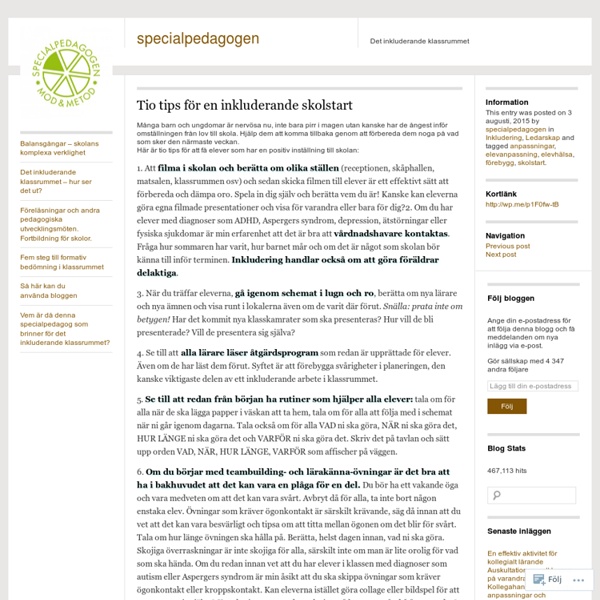



https://specialpedagogen.wordpress.com/2015/08/03/tio-tips-for-en-inkluderande-skolstart/
Related: Terminsstart • PlaneringFrom Visible Thinking Routines to 5 Modern Learning Routines I have been a fan of Visible Thinking Routines which were developed by Project Zero from Havard, for a while now. I have used these routines with students, as blogging routines and in professional development workshops. The Visible Thinking Routines website explains that: Routines exist in all classrooms; they are the patterns by which we operate and go about the job of learning and working together in a classroom environment. A routine can be thought of as any procedure, process, or pattern of action that is used repeatedly to manage and facilitate the accomplishment of specific goals or tasks.[…] Classrooms also have routines that structure the way students go about the process of learning As I am trying to make 21st century, modern, contemporary or “now” learning visible, it seemed a natural step to point out “Modern” or “Now” Learning Routines.
50 Beginning Of The School Year Procedures For A Stress-Free Classroom - 50 Beginning Of The School Year Procedures For A Stress-Free Classroom by TeachThought Staff Procedures can make a significant difference the learning of your students. Organization can lead to student engagement, and student engagement can lead to, of course, learning. Note that this post is all about classroom procedures–not your typical TeachThought fare, but considering you’re most likely a teacher, or work directly with teachers, it could make your life a bit easier.
The Best Resources For Learning How To Use The Dictogloss Strategy With English Language Learners Dictogloss is primarily a listening and writing activity used with English Language Learners. It can certainly be done a number of different ways but, very simply-put, the teacher reads a short text, often one students are familiar with. Then, after the first time of just listening, the teacher reads it again and students write down notes of what they have heard.
10 Back-To-School Tips For Teachers Using Google Docs 10 Back-To-School Tips For Teachers Using Google Docs by Google Collaborate with colleagues Establishing the ground rules But, no one is born knowing all the ‘tricks of the trade’ and most teachers learn the hard way, by their mistakes! Most of us (I hope!) can remember feeling completely out of their depth in a classroom situation at some point in their teaching careers. For example, in my first year of teaching, a particularly ‘lively’ group of ten and eleven year olds managed to lock me outside of the class; it was a very steep learning curve! I can still remember feeling my heart racing as the panic increased.
Feast Your Eyes on This Beautiful Linguistic Family Tree 552K 18.4KShare337 When linguists talk about the historical relationship between languages, they use a tree metaphor. An ancient source (say, Indo-European) has various branches (e.g., Romance, Germanic), which themselves have branches (West Germanic, North Germanic), which feed into specific languages (Swedish, Danish, Norwegian). Lessons on language families are often illustrated with a simple tree diagram that has all the information but lacks imagination.
7 Great Activities for the First Day of School New Year Resolutions Involve students in the creation of a set of classroom new year resolutions to guide you through the coming months. Work together to brainstorm resolutions, and write them on a sheet of chart paper. If necessary, reword them in a positive manner (such as "walk" rather than "don't run"). These may be resolutions for behavioral expectations (take turns) or class goals (learn our times tables). Psychology for Educators [And More] A lesson plan for all levels – in 10 ½ simple steps Preparation: Some fascinating recent studies have shown that on average teachers spend about 30 min preparing for each of their classes. Meanwhile other studies (conducted on planet Earth this time) show that such a time allocation may actually be unrealistic.
20 Ways to Avoid Peer Pressure Alison Bell (writing in Teen Magazine) suggests: 1. Ask 101 questions. For example, if a pal pressures you to smoke, ask her why she smokes, how long she has smoked, if she minds having ashtray breath. 2. Say “No” like you mean it. The Dos and Don'ts of Classroom Management: Your 25 Best Tips Posted 08/20/2014 1:55PM | Last Commented 03/29/2016 9:48AM Classroom management is a delicate balancing act often learned through experience and trial-and-error experimentation. Whether you're a new or experienced teacher, having strategies for effective classroom management is essential for creating positive, successful learning spaces (and staying sane!).
Hieroglyphics for Teachers: Graphic Communication in the Classroom – tekhnologic Before I first started English language teaching, someone gave me the advice that shouldn’t try to reinvent the wheel. Which is good advice. There are often things that have been written before, created before or done before. So, I am not going to reinvent the wheel, just Cave Art, although I say that rather hesitantly.